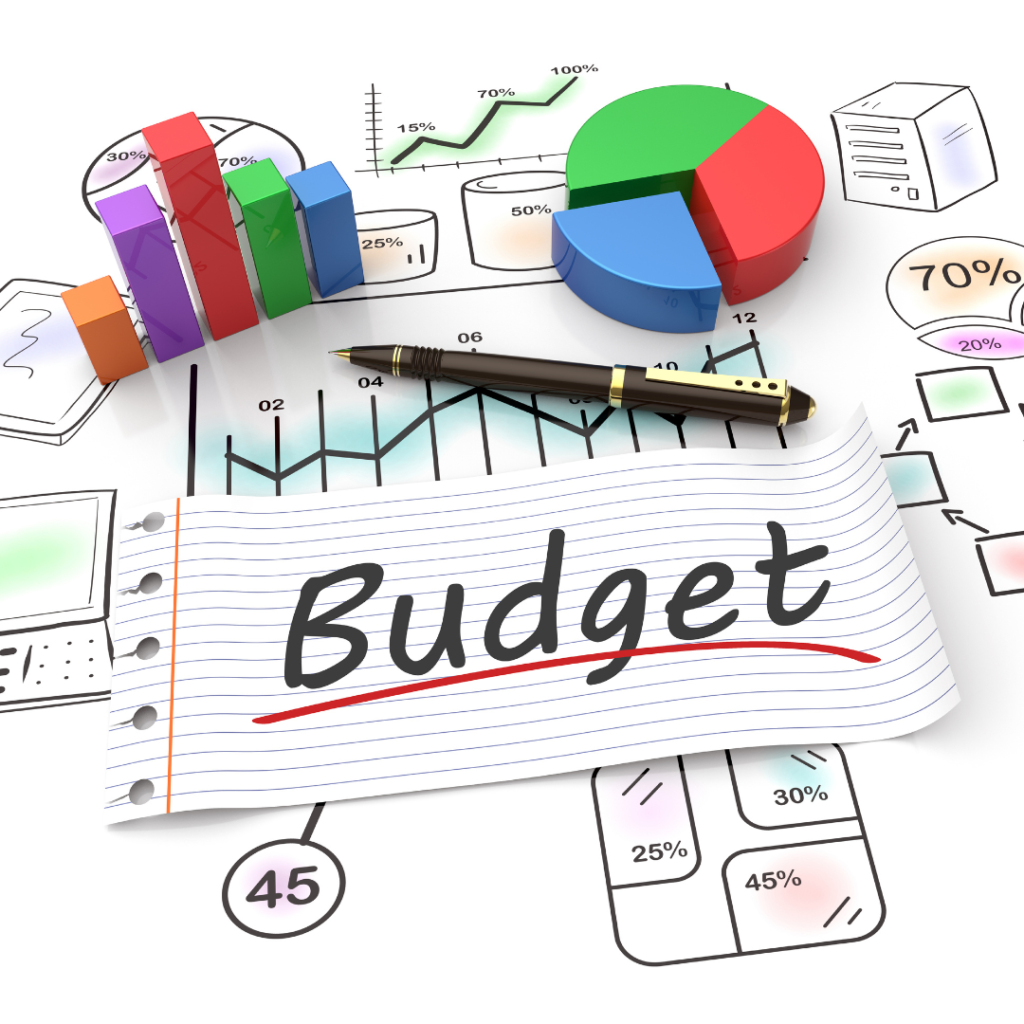Creating a budget is one of the most important steps you can take to manage your money and reach your financial goals. It may sound intimidating at first, but with a little bit of effort and some discipline, you can create a budget that works for you. In this post, we’ll show you how to create a budget in simple terms, step by step.
How to Create A Budget
Step 1: Track your income and expenses
The first step in creating a budget is to understand your current financial situation. You need to know how much money you earn and how much you spend each month. Start by tracking your income and expenses for a month or two. You can use a spreadsheet, a notebook, or a budgeting app to keep track of your transactions. Be sure to include all of your income sources (like your salary, bonuses, or side hustle income) and all of your expenses (like rent, groceries, transportation, utilities, and entertainment).
Step 2: Categorize your expenses
Once you have a good idea of how much you’re spending each month, categorize your expenses into groups. Common categories include housing, transportation, food, utilities, healthcare, entertainment, and savings. You can use the categories that make sense for your situation. Make sure you have a clear idea of how much you’re spending in each category.
Step 3: Set your financial goals
Before you create a budget, you need to know what you’re working towards. What are your financial goals? Do you want to save for a down payment on a house, pay off debt, or build an emergency fund? Once you know your goals, you can allocate your money accordingly in your budget.
Step 4: Create your budget
Now that you know your income, expenses, and financial goals, it’s time to create your budget. Start by subtracting your total expenses from your total income. If you have a positive number, that’s great! It means you’re living within your means. If you have a negative number, you need to find ways to cut back on your expenses or increase your income.
Next, allocate your money to the different categories in your budget. Be sure to prioritize your financial goals. For example, if your goal is to save for a down payment, allocate a significant portion of your budget toward your savings category.
Step 5: Stick to your budget
Creating a budget is only the first step. The real challenge is sticking to it. You need to be disciplined and make sure you’re not overspending in any category. One way to stay on track is to set up automatic transfers to your savings account and bill payments. Also, make sure to review your budget regularly and adjust it if necessary.
In conclusion, creating a budget is an essential step in managing your money and achieving your financial goals. By following these simple steps, you can create a budget that works for you and helps you take control of your finances. Remember, it’s important to be disciplined and stick to your budget to see real results.
Budgeting Tips
Budgeting is one of the most important things you can do to take control of your finances. It allows you to track your income and expenses, prioritize your spending, and work towards your financial goals. But, creating a budget is just the first step. To make your budget work for you, you need to follow some basic budgeting tips. In this post, we’ll show you some simple budgeting tips to help you stay on track and reach your financial goals.
Tip 1: Start with your goals
Before you start creating your budget, it’s important to know what you’re working towards. What are your financial goals? Do you want to pay off debt, save for a down payment on a house, or build an emergency fund? Once you know your goals, you can allocate your money accordingly in your budget.
Tip 2: Keep it simple
Creating a budget doesn’t have to be complicated. Start with the basics – track your income and expenses, categorize your spending, and allocate your money to the different categories. Don’t worry about creating a complex budget with dozens of categories. Keep it simple and focus on the categories that matter the most to you.
Tip 3: Track your spending
To make your budget work for you, you need to track your spending. Keep track of your transactions, either manually or with a budgeting app. This will help you stay on top of your expenses and make adjustments to your budget if necessary.
Tip 4: Be realistic
When creating your budget, be realistic about your expenses. Don’t underestimate how much you’re spending in certain categories. It’s better to overestimate your expenses than underestimate them and end up overspending. Be honest with yourself about your spending habits and make adjustments to your budget as needed.
Tip 5: Prioritize your spending
When allocating your money to the different categories, make sure to prioritize your spending. Start with your necessities, like housing, food, and transportation. Then, allocate money towards your financial goals, like saving for a down payment or paying off debt. Finally, allocate money towards your wants, like entertainment and dining out.
Tip 6: Review and adjust your budget regularly
Your budget is not set in stone. It’s important to review your budget regularly and make adjustments as necessary. If you find that you’re overspending in a certain category, adjust your budget to reduce your spending. If you have a windfall of money, like a tax refund or bonus, consider allocating some of it towards your financial goals.
Budgeting is an essential step in taking control of your finances. By following these simple budgeting tips, you can create a budget that works for you and helps you achieve your financial goals. Remember, to be realistic, prioritize your spending, and review your budget regularly.
Best Budgeting Apps
Budgeting can be a daunting task, but luckily there are some budgeting apps that can help you achieve your financial goals. These apps can help you track your spending, set financial goals, and stay on track with your budget. Below, we’ll show you some of the best budgeting apps available to help you manage your money.
- Mint
Mint is a popular budgeting app that is easy to use and can be accessed on your computer or phone. It allows you to track your spending, create a budget, and set financial goals. Mint automatically categorizes your expenses and sends alerts when you’re close to overspending in a category. It’s a great all-in-one budgeting app for people who want to see an overview of their finances.
- YNAB (You Need A Budget)
YNAB is a budgeting app that focuses on giving every dollar a job. It allows you to create a budget based on your income and expenses and helps you allocate your money to different categories. YNAB also offers financial education resources to help you improve your money management skills. It’s a great budgeting app for people who want to take a more hands-on approach to budgeting their funds.
- Personal Capital
Personal Capital is a budgeting app that focuses on investment tracking and retirement planning. It allows you to track your net worth, view your investment portfolio, and plan for retirement. Personal Capital also offers a free financial dashboard that shows your spending, income, and investments in one place. It’s a great budgeting app for people who want to focus on their long-term financial goals.
- PocketGuard
PocketGuard is a great budgeting app that helps you track your spending and create a budget. It also offers a unique feature that shows you how much money you have left to spend after your bills and savings are accounted for. PocketGuard allows you to set financial goals and offers tips to help you save money. It’s a great budgeting app for people who want a simple and easy-to-use budgeting app.
-
EveryDollar
EveryDollar is a budgeting app that was created by personal finance expert Dave Ramsey. It allows you to create a budget based on your income and expenses and gives you the tools to track your spending. EveryDollar offers financial education resources to help you improve your money management skills. It’s a great budgeting app for people who want to follow a budgeting system that is proven to work.
Budgeting apps can be a great tool to help you manage your finances. Whether you want an all-in-one budgeting app or a budgeting app that focuses on a specific area of your finances, there’s an app out there for you. Try out a few of these apps and find the one that works best for you.
Budget Worksheet | How to Use a Budget Worksheet?
A budget worksheet is a tool that helps you track your income and expenses. It typically includes categories for different types of expenses, such as housing, transportation, food, and entertainment. By tracking your spending, you can identify areas where you may be overspending and adjust your budget accordingly.
Creating and sticking to a budget is an important part of managing your finances. One way to help you keep track of your income and expenses is by using a budget worksheet. Highlighted below are ways you can use a budget worksheet to realize your financial goal. In this post, we’ll show you how to use a budget worksheet to manage your money.
How to Use a Budget Worksheet
Here are ways to use a budget worksheet;
- Determine Your Income
The first step in creating a budget worksheet is to determine your income. This can include your salary, any side hustles or freelance work, and any other sources of income. Write down your total monthly income at the top of the worksheet.
- List Your Expenses
Next, list all of your expenses. Start with your fixed expenses, such as rent or mortgage, car payments, and insurance. Then, list your variable expenses, such as groceries, dining out, and entertainment. Be sure to include any bills or expenses that may only occur once or twice a year, such as a car registration fees or property taxes.
- Assign a Dollar Amount to Each Expense
For each expense, assign a dollar amount that you expect to spend each month. This can be based on your previous spending habits or estimates if you’re new to budgeting.
- Calculate Your Totals
Once you’ve listed all of your income and expenses, calculate your totals. Subtract your total expenses from your total income to determine whether you have a surplus or a deficit. If you have a surplus, consider adding to your savings or investing in your long-term financial goals. If you have a deficit, look for areas where you can cut back on spending or consider finding ways to increase your income.
- Review and Adjust
Review your budget worksheet regularly to ensure you’re staying on track with your spending. You may need to adjust your budget if you have unexpected expenses or changes in income. By regularly reviewing and adjusting your budget, you’ll be better equipped to manage your finances and achieve your financial goals.
In conclusion, a budget worksheet can be a useful tool to help you manage your finances. By tracking your income and expenses, you can identify areas where you may be overspending and adjust your budget accordingly. Be sure to regularly review and adjust your budget to stay on track with your financial goals.


